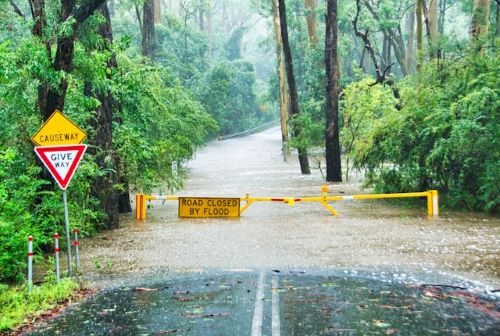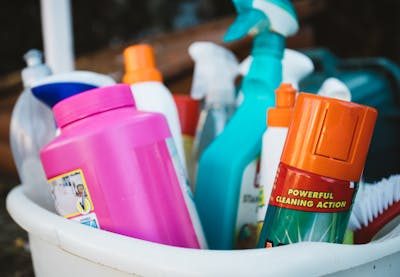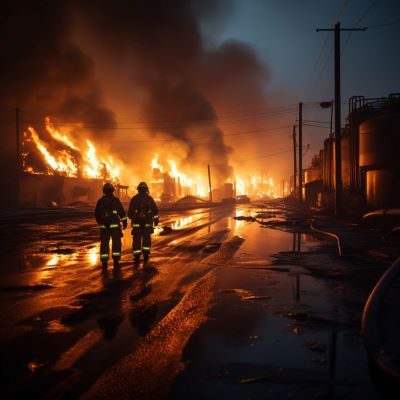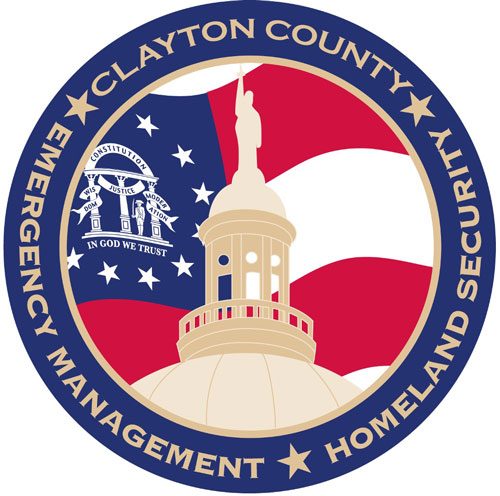
Chief Resilience Officer/Director of Emergency Management
David Vazquez
Phone: (770) 473-5847
1590 Adamson Parkway, Suite 370 Morrow, GA 30260
Operating Hours:
Monday – Friday:
8:00 a.m. – 5:00 p.m.

Be Informed

Emergency preparedness is not the sole concern of Californians for earthquakes, those who live in “Tornado Alley”; or Gulf Coast residents because of hurricanes. Most communities may be impacted by several types of hazards during a lifetime. Americans also travel more than ever before; to areas impacted by hazards they may not be at risk of near their homes. Knowing what to do before, during and after an emergency is a critical part of being prepared and may make all the difference when seconds count.
Some of the basic protective actions are similar for multiple hazards. For example, safety is necessary when experiencing all hazards, whether this means sheltering or evacuating depends on the specific emergency. Developing a family communications plan or making an emergency supply kit are the same for accidental emergencies, natural disasters and also terrorism. However, there are important differences among potential emergencies that should impact the decisions you make and the actions you take.
Use the links on this page to learn about the potential emergencies that can happen where you live and the appropriate ways to respond to them. When you know what to do, you can plan with your household and prepare in advance to be ready. These links also provide information about how protect your household and begin recovery following the initial disaster.
Natural Disasters
Natural disasters such as flood, fire, earthquake, tornado and windstorm affect thousands of people every year. You should know what your risks are and prepare to protect yourself, your family and community. Recognizing an impending hazard and knowing what to do to protect yourself and your family will help you take effective steps to prepare beforehand and aid recovery after the event.
Some of the things you can do to prepare for the unexpected, such as assembling a supply kit and developing a family emergency plan, are the same for all types of hazards. However each emergency is unique and knowing the actions to take for each threat will impact the specific decisions and preparations you make.
Drought

Always observe state and local restrictions on water use during a drought. If restricted, for example, do not water your lawn, wash your car, or other non-essential uses, to help ensure there is enough water for essential uses.
WATER CONSERVATION TIPS WHILE IN A DROUGHT
BATHROOM
- Avoid flushing the toilet unnecessarily. Dispose of tissues, insects, and other similar waste in the trash rather than the toilet.
- Avoid taking baths—take short showers—turn on water only to get wet and lather and then again to rinse off.
- Avoid letting the water run while brushing your teeth, washing your face or shaving.
- Place a bucket in the shower to catch excess water for watering plants.
KITCHEN
- Operate automatic dishwashers only when they are fully loaded. Use the "light wash" feature, if available, to use less water.
- Hand wash dishes by filling two containers—one with soapy water and the other with rinse water containing a small amount of chlorine bleach.
- Clean vegetables in a pan filled with water rather than running water from the tap.
- Store drinking water in the refrigerator. Do not let the tap run while you are waiting for water to cool.
- Avoid wasting water waiting for it to get hot. Capture it for other uses such as plant watering or heat it on the stove or in a microwave.
- Avoid rinsing dishes before placing them in the dishwasher; just remove large particles of food. (Most dishwashers can clean soiled dishes very well, so dishes do not have to be rinsed before washing)
- Avoid using running water to thaw meat or other frozen foods. Defrost food overnight in the refrigerator or use the defrost setting on your microwave oven.
LAUNDRY
- Operate automatic clothes washers only when they are fully loaded or set the water level for the size of your load.
CAR WASHING
- Use a commercial car wash that recycles water.
- If you wash your own car, use a shut-off nozzle that can be adjusted down to a fine spray on your hose.
LAWN CARE
- Avoid over watering your lawn and water only when needed:
- A heavy rain eliminates the need for watering for up to two weeks. Most of the year, lawns only need one inch of water per week.
- Check the soil moisture levels with a soil probe, spade or large screwdriver. You don't need to water if the soil is still moist. If your grass springs back when you step on it, it doesn't need water yet.
- If your lawn does require watering, do so early in the morning or later in the evening, when temperatures are cooler.
- Check your sprinkler system frequently and adjust sprinklers so only your lawn is watered and not the house, sidewalk, or street.
- Water in several short sessions rather than one long one, in order for your lawn to better absorb moisture and avoid runoff.
- Use a broom or blower instead of a hose to clean leaves and other debris from your driveway or sidewalk.
- Avoid leaving sprinklers or hoses unattended. A garden hose can pour out 600 gallons or more in only a few hours.
- In extreme drought, allow lawns to die in favor of preserving trees and large shrubs.
Extreme Heat
 Heat kills by pushing the human body beyond its limits. In extreme heat and high humidity, evaporation is slowed and the body must work extra hard to maintain a normal temperature.
Heat kills by pushing the human body beyond its limits. In extreme heat and high humidity, evaporation is slowed and the body must work extra hard to maintain a normal temperature.
Most heat disorders occur because the victim has been overexposed to heat or has over-exercised for his or her age and physical condition. Older adults, young children and those who are sick or overweight are more likely to succumb to extreme heat.
Conditions that can induce heat-related illnesses include stagnant atmospheric conditions and poor air quality. Consequently, people living in urban areas may be at greater risk from the effects of a prolonged heat wave than those living in rural areas. Also, asphalt and concrete store heat longer and gradually release heat at night, which can produce higher nighttime temperatures known as the "urban heat island effect."
A heat wave is an extended period of extreme heat, and is often accompanied by high humidity. These conditions can be dangerous and even life-threatening for humans who don't take the proper precautions.
What you should do if the weather is extremely hot:
- Listen to NOAA Weather Radio for critical updates from the National Weather Service (NWS).
- Never leave children or pets alone in closed vehicles.
- Stay indoors as much as possible and limit exposure to the sun.
- Stay on the lowest floor out of the sunshine if air conditioning is not available.
- Postpone outdoor games and activities.
- Consider spending the warmest part of the day in public buildings such as libraries, schools, movie theaters,
- shopping malls, and other community facilities. Circulating air can cool the body by increasing the perspiration rate of evaporation.
- Eat well-balanced, light, and regular meals. Avoid using salt tablets unless directed to do so by a physician.
- Drink plenty of water; even if you do not feel thirsty. Avoid drinks with caffeine. Persons who have epilepsy or heart, kidney, or liver disease; are on fluid-restricted diets; or have a problem with fluid retention should consult a doctor before increasing liquid intake.
- Limit intake of alcoholic beverages.
- Dress in loose-fitting, lightweight, and light-colored clothes that cover as much skin as possible. Avoid dark colors because they absorb the sun’s rays.
- Protect face and head by wearing a wide-brimmed hat.
- Avoid strenuous work during the warmest part of the day. Use a buddy system when working in extreme heat, and take frequent breaks.
- Check on family, friends, and neighbors who do not have air conditioning and who spend much of their time alone.
- Avoid extreme temperature changes.
- Check on your animals frequently to ensure that they are not suffering from the heat. Go to a designated public shelter if your home loses power during periods of extreme heat. Text SHELTER + your ZIP code to 43362 (4FEMA) to find the nearest shelter in your area (example: shelter 12345).
Floods & Flash Floods
 Floods are one of the most common hazards in the United States, however not all floods are alike. Some floods develop slowly, while others such a flash floods, can develop in just a few minutes and without visible signs of rain. Additionally, floods can be local, impacting a neighborhood or community, or very large, affecting entire river basins and multiple states.
Floods are one of the most common hazards in the United States, however not all floods are alike. Some floods develop slowly, while others such a flash floods, can develop in just a few minutes and without visible signs of rain. Additionally, floods can be local, impacting a neighborhood or community, or very large, affecting entire river basins and multiple states.
Flash floods can occur within a few minutes or hours of excessive rainfall, a dam or levee failure, or a sudden release of water held by an ice jam. Flash floods often have a dangerous wall of roaring water carrying rocks, mud and other debris. Overland flooding, the most common type of flooding event typically occurs when waterways such as rivers or streams overflow their banks as a result of rainwater or a possible levee breach and cause flooding in surrounding areas. It can also occur when rainfall or snowmelt exceeds the capacity of underground pipes, or the capacity of streets and drains designed to carry flood water away from urban areas.
Be aware of flood hazards no matter where you live or work, but especially if you are in low-lying areas, near water, behind a levee or downstream from a dam. Even very small streams, gullies, creeks, culverts, dry streambeds or low-lying ground that appear harmless in dry weather can flood.
Thunderstorms & Lightning
Before Thunderstorm & Lightning
To prepare for a thunderstorm, you should do the following:
- To begin preparing, you should build an emergency kit and make a family communications plan.
- Remove dead or rotting trees and branches that could fall and cause injury or damage during a severe thunderstorm.
- Postpone outdoor activities.
- Remember the 30/30 Lightning Safety Rule: Go indoors if, after seeing lightning, you cannot count to 30 before hearing thunder. Stay indoors for 30 minutes after hearing the last clap of thunder.
- Secure outdoor objects that could blow away or cause damage.
- Get inside a home, building, or hard top automobile (not a convertible). Although you may be injured if lightning strikes your car, you are much safer inside a vehicle than outside.
- Remember, rubber-soled shoes and rubber tires provide NO protection from lightning. However, the steel frame of a hard-topped vehicle provides increased protection if you are not touching metal.
- Shutter windows and secure outside doors. If shutters are not available, close window blinds, shades or curtains.
- Unplug any electronic equipment well before the storm arrives.
During Thunderstorms & Lightning
If thunderstorm and lightning are occurring in your area, you should:
- Use your battery-operated NOAA Weather Radio for updates from local officials.
- Avoid contact with corded phones and devices including those plugged into electric for recharging. Cordless and wireless phones not connected to wall outlets are OK to use.
- Avoid contact with electrical equipment or cords. Unplug appliances and other electrical items such as computers and turn off air conditioners. Power surges from lightning can cause serious damage.
- Avoid contact with plumbing. Do not wash your hands, do not take a shower, do not wash dishes, and do not do laundry. Plumbing and bathroom fixtures can conduct electricity.
- Stay away from windows and doors, and stay off porches.
- Do not lie on concrete floors and do not lean against concrete walls.
- Avoid natural lightning rods such as a tall, isolated tree in an open area.
- Avoid hilltops, open fields, the beach or a boat on the water.
- Take shelter in a sturdy building. Avoid isolated sheds or other small structures in open areas.
- Avoid contact with anything metal—tractors, farm equipment, motorcycles, golf carts, golf clubs, and bicycles.
- If you are driving, try to safely exit the roadway and park. Stay in the vehicle and turn on the emergency flashers until the heavy rain ends. Avoid touching metal or other surfaces that conduct electricity in and outside the vehicle.
More Information
Tornadoes
 Before a Tornado
Before a Tornado
- To begin preparing, you should build an emergency kit and make a family communications plan.
- Listen to NOAA Weather Radio or to commercial radio or television newscasts for the latest information. In any emergency, always listen to the instructions given by local emergency management officials.
- Be alert to changing weather conditions. Look for approaching storms.
- Look for the following danger signs:
- Dark, often greenish sky
- Large hail
- A large, dark, low-lying cloud (particularly if rotating)
- Loud roar, similar to a freight train.
- If you see approaching storms or any of the danger signs, be prepared to take shelter immediately.
- If you are under a tornado warning, seek shelter immediately! Most injuries associated with high winds are from flying debris, so remember to protect your head.
After a Tornado
Injury may result from the direct impact of a tornado or it may occur afterward when people walk among debris and enter damaged buildings. A study of injuries after a tornado in Marion, Illinois, showed that 50 percent of the tornado-related injuries were suffered during rescue attempts, cleanup and other post-tornado activities. Nearly a third of the injuries resulted from stepping on nails. Because tornadoes often damage power lines, gas lines or electrical systems, there is a risk of fire, electrocution or an explosion. Protecting yourself and your family requires promptly treating any injuries suffered during the storm and using extreme care to avoid further hazards.
Accidental Hazards
Technological & Accidental Hazards include technological hazards such as nuclear power plant failures and hazardous materials incidents. Usually, little or no warning precedes these disasters.
Unfortunately, the number of potential accidental disasters is escalating due to the increased number of new substances and the opportunities for human error while using these materials.
Learn what actions to include in your family disaster plan to prepare for and respond to such incidents. For example, in your own home, you can learn how to use, store and dispose of household chemicals in a manner that will reduce the potential for injury to people and the environment.
Blackouts

- Use only flashlights for emergency lighting. NEVER use candles during a blackout or power outage due to extreme risk of fire.
- Keep refrigerator and freezer doors closed to keep your food as fresh as possible. If you must eat food that was refrigerated or frozen, check it carefully for signs of spoilage. •Turn off or disconnect appliances, equipment (like air conditioners) or electronics in use when the power went out. Power may return with momentary "surges” or “spikes” that can damage computers as well as motors in appliances like the air conditioner, refrigerator, washer or furnace.
- Do not run a generator inside a home or garage.
- Do not connect a generator to a home's electrical system. If you use a generator, connect the equipment you want to run directly to the outlets on the generator.
- Listen to local radio and to a battery- or generator-powered television for updated information.
- Leave on one light so that you'll know when your power returns.
- Use a standard telephone handset, cellular phone, radio or pager if your phone requires electricity to work, as do cordless phones and answering machines. Use the phone for emergencies only. Listen to a portable radio for the latest information.
- Do not call 9-1-1 for information—call only to report a life-threatening emergency. Use the phone for life-threatening emergencies only.
- Take steps to remain cool if it is hot outside. In intense heat when the power may be off for a long time, consider going to a movie theater, shopping mall or “cooling shelter” that may be open in your community. If you remain at home, move to the lowest level of your home, since cool air falls. Wear lightweight, light-colored clothing.
- Drink plenty of water, even if you do not feel thirsty.
- Put on layers of warm clothing if it is cold outside. Never burn charcoal for heating or cooking indoors. Never use your oven as a source of heat. If the power may be out for a prolonged period, plan to go to another location (the home of a relative or friend, or a public facility) that has heat to keep warm.
- Provide plenty of fresh, cool water for your pets.
- Eliminate unnecessary travel, especially by car. Traffic signals will stop working during an outage, creating traffic congestion.
- Remember that equipment such as automated teller machines (ATMs) and elevators may not work during a power outage.
Household Chemical Emergencies
 Get out of the residence immediately if there is a danger of fire or explosion. Do not waste time collecting items or calling the fire department when you are in danger. Call the fire department from outside (a cellular phone or a neighbor’s phone) once you are safely away from danger. Stay upwind and away from the residence to avoid breathing toxic fumes. Recognize and respond to symptoms of toxic poisoning including:
Get out of the residence immediately if there is a danger of fire or explosion. Do not waste time collecting items or calling the fire department when you are in danger. Call the fire department from outside (a cellular phone or a neighbor’s phone) once you are safely away from danger. Stay upwind and away from the residence to avoid breathing toxic fumes. Recognize and respond to symptoms of toxic poisoning including:
- Difficulty breathing
- Irritation of the eyes, skin, throat, or respiratory tract
- Changes in skin color
- Headache or blurred vision
- Dizziness
- Clumsiness or lack of coordination
- Cramps or diarrhea
If someone is experiencing toxic poisoning symptoms or has been exposed to a household chemical, call the national poison control center at 1 (800) 222-1222 and find any containers of the substance that are readily available in order to provide requested information.
Follow the emergency operator or dispatcher’s first aid instructions carefully. The first aid advice found on containers may be out of date or inappropriate. Do not give anything by mouth unless advised to do so by a medical professional.
Hazardous Materials Incidents
 Many communities have Local Emergency Planning Committees (LEPCs) whose responsibilities include collecting information about hazardous materials in the community and making this information available to the public upon request. The LEPCs also are tasked with developing an emergency plan to prepare for and respond to chemical emergencies in the community. Ways the public will be notified and actions the public must take in the event of a release are part of the plan.
Many communities have Local Emergency Planning Committees (LEPCs) whose responsibilities include collecting information about hazardous materials in the community and making this information available to the public upon request. The LEPCs also are tasked with developing an emergency plan to prepare for and respond to chemical emergencies in the community. Ways the public will be notified and actions the public must take in the event of a release are part of the plan.
Contact the LEPCs to find out more about chemical hazards and what needs to be done to minimize the risk to individuals and the community from these materials. Your local emergency management office can provide contact information on the LEPCs. Find your state office or agency of emergency management
The following are things you can do to protect yourself, your family and your property from the effects of a hazardous materials incident:
- Build an Emergency Supply Kit, which includes items like non-perishable food, water, a battery-powered or hand-crank radio, extra flashlights and batteries. You should add plastic sheeting, duct tape and scissors to the kit in order be better prepared for a hazardous materials incident. You may want to prepare a portable kit and keep it in your car in case you are told to evacuate.
- Make a Family Emergency Plan. Your family may not be together when disaster strikes, so it is important to know how you will contact one another, how you will get back together and what you will do in case of an emergency.
Terrorist Hazards
Throughout human history, there have been many threats to the security of nations. These threats have brought about large-scale losses of life, the destruction of property, widespread illness and injury, the displacement of large numbers of people and devastating economic loss. Recent technological advances and ongoing political unrest are components of the increased risk to national security. Learn what actions to include in your family disaster plan to prepare for and respond to terrorist threats.
Biological Threats
 Biological agents are organisms or toxins that can kill or incapacitate people, livestock and crops. A biological attack is the deliberate release of germs or other biological substances that can make you sick. The three basic groups of biological agents that would likely be used as weapons are bacteria, viruses and toxins. Most biological agents are difficult to grow and maintain. Many break down quickly when exposed to sunlight and other environmental factors, while others, such as anthrax spores, are very long lived. Biological agents can be dispersed by spraying them into the air, by infecting animals that carry the disease to humans and by contaminating food and water. Delivery methods include:
Biological agents are organisms or toxins that can kill or incapacitate people, livestock and crops. A biological attack is the deliberate release of germs or other biological substances that can make you sick. The three basic groups of biological agents that would likely be used as weapons are bacteria, viruses and toxins. Most biological agents are difficult to grow and maintain. Many break down quickly when exposed to sunlight and other environmental factors, while others, such as anthrax spores, are very long lived. Biological agents can be dispersed by spraying them into the air, by infecting animals that carry the disease to humans and by contaminating food and water. Delivery methods include:
- Aerosols - biological agents are dispersed into the air, forming a fine mist that may drift for miles. Inhaling the agent may cause disease in people or animals.
- Animals - some diseases are spread by insects and animals, such as fleas, mice, flies, mosquitoes and livestock.
- Food and water contamination - some pathogenic organisms and toxins may persist in food and water supplies. Most microbes can be killed, and toxins deactivated, by cooking food and boiling water. Most microbes are killed by boiling water for one minute, but some require longer. Follow official instructions.
- Person-to-person - spread of a few infectious agents is also possible. Humans have been the source of infection for smallpox, plague, and the Lassa viruses.
Specific information on biological agents is available through the Centers for Disease Control and Prevention.
Chemical Threats
 Chemical agents are poisonous vapors, aerosols, liquids and solids that have toxic effects on people, animals or plants. They can be released by bombs or sprayed from aircraft, boats and vehicles. They can be used as a liquid to create a hazard to people and the environment. Some chemical agents may be odorless and tasteless. They can have an immediate effect (a few seconds to a few minutes) or a delayed effect (2 to 48 hours). While potentially lethal, chemical agents are difficult to deliver in lethal concentrations. Outdoors, the agents often dissipate rapidly. Chemical agents also are difficult to produce.
Chemical agents are poisonous vapors, aerosols, liquids and solids that have toxic effects on people, animals or plants. They can be released by bombs or sprayed from aircraft, boats and vehicles. They can be used as a liquid to create a hazard to people and the environment. Some chemical agents may be odorless and tasteless. They can have an immediate effect (a few seconds to a few minutes) or a delayed effect (2 to 48 hours). While potentially lethal, chemical agents are difficult to deliver in lethal concentrations. Outdoors, the agents often dissipate rapidly. Chemical agents also are difficult to produce.
A chemical attack could come without warning. Signs of a chemical release include people having difficulty breathing; experiencing eye irritation; losing coordination; becoming nauseated; or having a burning sensation in the nose, throat and lungs. Also, the presence of many dead insects or birds may indicate a chemical agent release.
Cyber Attacks
Often times, we may not realize that our actions online might put us, our families, and even our country at risk. Learning about the dangers online and taking action to protect ourselves is the first step in making the Internet a safer place for everyone. Cybersecurity is a shared responsibility and we each have a role to play.
Cybersecurity involves protecting that infrastructure by preventing, detecting, and responding to cyber incidents. Unlike physical threats that prompt immediate action–like stop, drop, and roll in the event of a fire–cyber threats are often difficult to identify and comprehend. Among these dangers are viruses erasing entire systems, intruders breaking into systems and altering files, intruders using your computer or device to attack others, or intruders stealing confidential information. The spectrum of cyber risks is limitless; threats, some more serious and sophisticated than others, can have wide-ranging effects on the individual, community, organizational, and national level. These risks include:
Organized cybercrime, state-sponsored hackers, and cyber espionage can pose national security risks to our country.
Transportation, power, and other services may be disrupted by large scale cyber incidents. The extent of the disruption is highly uncertain as it will be determined by many unknown factors such as the target and size of the incident.
Vulnerability to data breach and loss increases if an organization’s network is compromised. Information about a company, its employees, and its customers can be at risk.
Individually-owned devices such as computers, tablets, mobile phones, and gaming systems that connect to the Internet are vulnerable to intrusion. Personal information may be at risk without proper security.
For more information about what to do before, during or after a cyber incident, please visit Ready.Gov Cyber Incidents.
Radiological Dispersion Device (RDD)
 Terrorist use of an RDD — often called “dirty nuke” or “dirty bomb” — is considered far more likely than use of a nuclear explosive device. An RDD combines a conventional explosive device — such as a bomb — with radioactive material. It is designed to scatter dangerous and sub-lethal amounts of radioactive material over a general area. Such RDDs appeal to terrorists because they require limited technical knowledge to build and deploy compared to a nuclear device. Also, the radioactive materials in RDDs are widely used in medicine, agriculture, industry and research, and are easier to obtain than weapons grade uranium or plutonium.
Terrorist use of an RDD — often called “dirty nuke” or “dirty bomb” — is considered far more likely than use of a nuclear explosive device. An RDD combines a conventional explosive device — such as a bomb — with radioactive material. It is designed to scatter dangerous and sub-lethal amounts of radioactive material over a general area. Such RDDs appeal to terrorists because they require limited technical knowledge to build and deploy compared to a nuclear device. Also, the radioactive materials in RDDs are widely used in medicine, agriculture, industry and research, and are easier to obtain than weapons grade uranium or plutonium.
The primary purpose of terrorist use of an RDD is to cause psychological fear and economic disruption. Some devices could cause fatalities from exposure to radioactive materials. Depending on the speed at which the area of the RDD detonation was evacuated or how successful people were at sheltering-in-place, the number of deaths and injuries from an RDD might not be substantially greater than from a conventional bomb explosion.
The size of the affected area and the level of destruction caused by an RDD would depend on the sophistication and size of the conventional bomb, the type of radioactive material used, the quality and quantity of the radioactive material, and the local meteorological conditions - primarily wind and precipitation. The area affected could be placed off-limits to the public for several months during cleanup efforts.
For more information about what to do before, during or after a radiological event, please visit Ready.gov Radiological Dispersion Device.
Options for Protection
Depending on your circumstances and the nature of the emergency, the first important decision is whether you stay where you are or evacuate.You should understand and plan for both possibilities. Use common sense and available information, including what you are learning here, to determine if there is an immediate danger. In any emergency, local authorities may or may not immediately be able to provide information on what is happening and what you should do. However, you should watch TV, listen to the radio or check the Internet often for information or official instruction as it becomes available. Read further information about staying put or sheltering in place.
EMERGENCY INFORMATION
Find out what kinds of disasters, both natural and man-made, are most likely to occur in your area and how you will be notified. Methods of getting your attention vary from community to community. One common method is to broadcast via emergency radio and TV broadcasts. You might hear a special siren, or get a telephone call, or emergency workers may go door-to-door.
EMERGENCY PLANS
You may also want to inquire about emergency plans at places where your family spends time: work, daycare and school. If no plans exist, consider volunteering to help create one. Talk to your neighbors about how you can work together in the event of an emergency. You will be better prepared to safely reunite your family and loved ones during an emergency if you think ahead and communicate with others in advance.
Shelter
Taking appropriate shelter is critical in times of disaster. Sheltering is appropriate when conditions require that you seek protection in your home, place of employment or other location when disaster strikes. Sheltering outside the hazard area could include staying with friends and relatives, seeking commercial lodging or staying in a mass care facility operated by disaster relief groups.
To effectively shelter, you must first consider the hazard and then choose a place in your home or other building that is safe for that hazard. For example, for a tornado, a room should be selected that is in a basement or an interior room on the lowest level away from corners, windows, doors and outside walls.
The safest locations to seek shelter vary by hazard. Be informed about the sheltering suggestions for each hazard.
There may be situations, depending on your circumstances and the nature of the disaster, when it’s simply best to stay where you are and avoid any uncertainty outside by “sheltering in place”.
The length of time you are required to shelter may be short, such as during a tornado warning, or long, such as during a winter storm or a pandemic. It is important that you stay in shelter until local authorities say it is safe to leave. Additionally, you should take turns listening to radio broadcasts and maintain a 24-hour safety watch.
Mass Care Shelters
Even though mass care shelters often provide water, food, medicine and basic sanitary facilities, you should plan to take your disaster supplies kit with you so you will have the supplies you require. Mass care sheltering can involve living with many people in a confined space, which can be difficult and unpleasant. To avoid conflicts in the stressful situation, it is important to cooperate with shelter managers and others assisting them. Keep in mind that alcoholic beverages and weapons are forbidden in emergency shelters and smoking is restricted.
Search for open shelters by texting SHELTER and a Zip Code to 43362 (4FEMA). Ex: Shelter 01234 (standard rates apply)
Learn more by visiting: http://www.disasterassistance.gov/
Shelter in Place
Whether you are at home, work or elsewhere, there may be situations when it's simply best to stay where you are and avoid any uncertainty outside.
There may be circumstances when staying put and creating a barrier between yourself and potentially contaminated air outside, a process known as "sealing the room," is a matter of survival.
Use common sense and available information to assess the situation and determine if there is immediate danger. If you see large amounts of debris in the air, or if local authorities say the air is badly contaminated, you may want to take this kind of action.
The process used to seal the room is considered a temporary protective measure to create a barrier between you and potentially contaminated air outside. It is a type of sheltering in place that requires preplanning.
- Bring your family and pets inside.
- Lock doors, close windows, air vents and fireplace dampers.
- Turn off fans, air conditioning and forced air heating systems.
- Take your emergency supply kit unless you have reason to believe it has been contaminated.
- Go into an interior room with few windows, if possible.
- Seal all windows, doors and air vents with 2-4 mil. thick plastic sheeting and duct tape. Consider measuring and cutting the sheeting in advance to save time.
- Cut the plastic sheeting several inches wider than the openings and label each sheet.
- Duct tape plastic at corners first and then tape down all edges.
- Be prepared to improvise and use what you have on hand to seal gaps so that you create a barrier between yourself and any contamination.
Local authorities may not immediately be able to provide information on what is happening and what you should do. However, you should watch TV, listen to the radio or check the Internet often for official news and instructions as they become available.
Community & Other Plans
Ask local officials the following questions about your community’s disaster/emergency plans. What hazards are most likely?
- How will I get alerts and warnings?
- What is the advice and plans for sheltering and evacuation for the hazards that may impact the community?
- Are there emergency contact numbers I should have for different situations?
- Are there opportunities for preparedness education and training?
- Does my community have a plan?Can I obtain a copy?
- What does the plan contain?
- How often are plans updated?
- What should I know about this plan?
- What hazards does it cover?
In addition to finding out about your community’s plan, it is important that you know what plans are in place for your workplace, your children’s school or day care center and any places you frequent like entertainment and sporting events, recreation areas, shopping centers and places of worship.
Ask your employer about workplace policies regarding disasters and emergencies, including understanding how you will be provided emergency and warning information, evacuation and shelter plans.
Contact your children’s school or day care center to discuss their disaster procedures.
Recovery From Disaster
Recovering from a disaster is usually a gradual process. Safety is a primary issue, as are mental and physical well-being. If assistance is available, knowing how to access it makes the process faster and less stressful.
About EMA
Preparedness
Training
LEPC




 Click Clayton
Click Clayton










 Before a Tornado
Before a Tornado